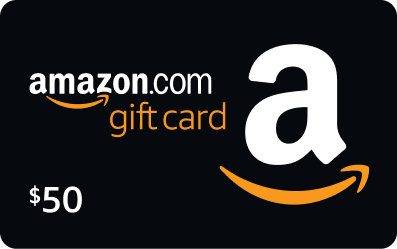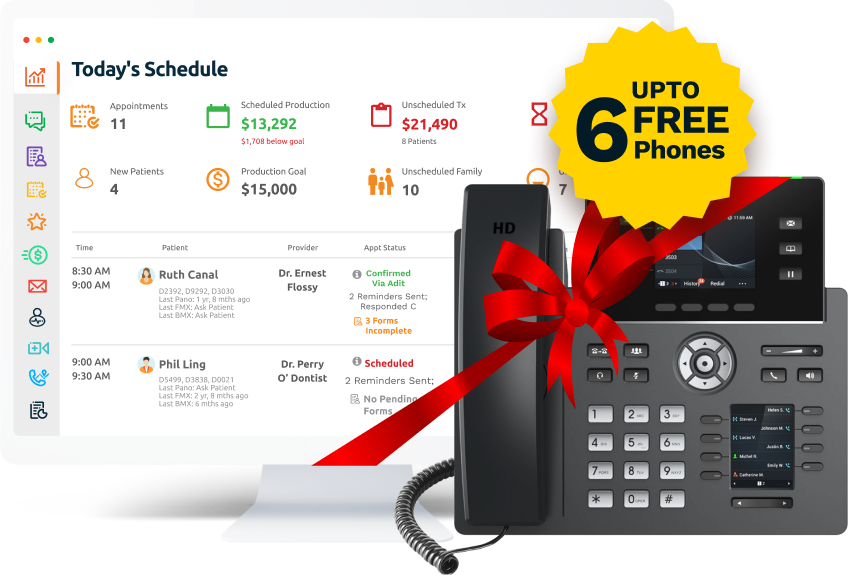Ends in
ends in 100 Days

ends in 100 Days

ends 11 July
How to Pick a Dental Office Communication System

In a world where convenience is king, patients expect fast, flexible communication. An efficient system allows patients to confirm appointments via text, fill out digital forms at their convenience, and receive reminders about upcoming visits. For your staff, an integrated dental office communication system ensures better collaboration to minimize errors like overbooking, delayed responses, or miscommunications that could impact patient care or overall efficiency.
If your dental office isn't able to meet these expectations, it may be time to re-evaluate your current system and choose something more modern and comprehensive.
Elements of Dental Office Communication Systems
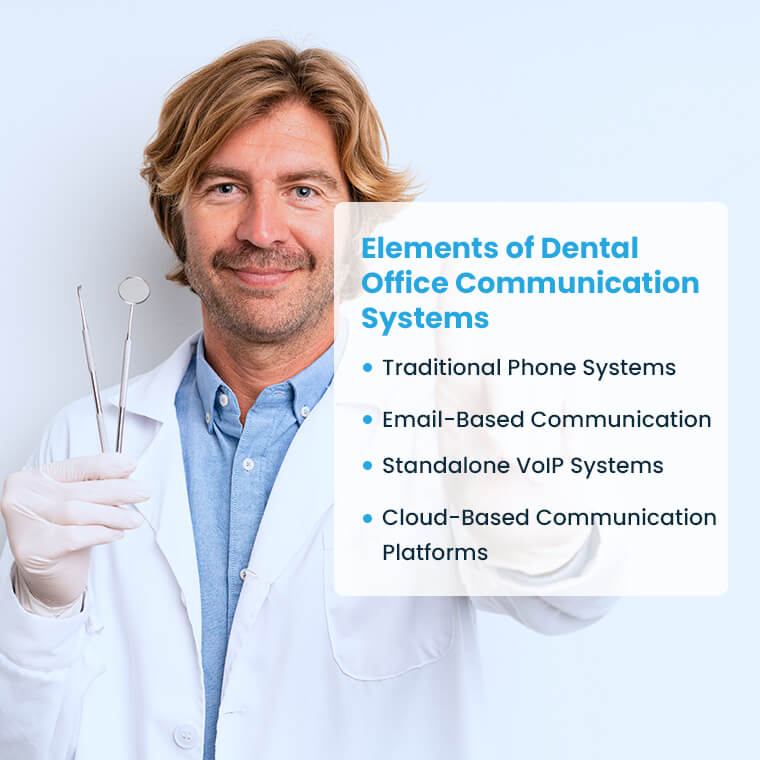
Effective communication is the heartbeat of any successful dental practice, ensuring that everything runs smoothly and patients feel well cared for. In a busy dental office, it's a necessity to use multiple communication tools to maximize patient engagement.
From quick text updates to collaborative in-house chats, email reminders, and even telemedicine options, each element plays a vital role in keeping everyone connected. When these communication methods work together seamlessly, they not only streamline operations but also enhance the patient experience, making visits more pleasant and efficient.
Here's an in-depth look at the most popular dental communication systems and their pros and cons:
1. Traditional Phone Systems
Traditional phone systems have long been the backbone of communication in dental practices. While known for their reliability and simplicity, these landline systems fall short in functionality when compared to modern alternatives like VoIP. They lack integration with dental practice management software, which limits efficiency and data management.
As dental offices evolve, relying solely on traditional phone systems can hinder communication and increase operational costs, which is why dentists are now seeking more advanced solutions.
Pros:
- Reliability: Consistent performance ensures calls can be made and received without technical issues, which is vital for maintaining communication with patients.
- Familiarity: Staff are accustomed to these systems, requiring minimal training, which allows for a smooth transition without disrupting patient care.
Cons:
- High Operational Costs: Monthly fees for landline services can be significantly higher than VoIP alternatives, straining budgets.
- No Integration with Practice Management Tools: Lack of integration leads to inefficient communication and complicates record-keeping.
- Limited Functionality: Absence of advanced features like call tracking and automated reminders reduces operational efficiency.
2. Email-Based Communication
Email is a fundamental communication tool in dental practices, commonly used for appointment confirmations, patient inquiries, sharing treatment plans, and cost-effective marketing campaigns to boost brand reach. It provides a secure way to transmit sensitive information, which is essential for maintaining patient trust.
While email effectively conveys detailed messages, it is typically used alongside traditional phone systems or VoIP services. This combination can present challenges, as email often lacks the immediacy needed for urgent communication in a fast-paced dental environment. Understanding the strengths and limitations of email is crucial for optimizing patient interactions and enhancing overall office efficiency.
Pros:
- Secure Sharing: Email allows for the transmission of sensitive information in compliance with privacy regulations, maintaining patient trust.
Cons:
- Slow Response Times: Delays in checking emails can frustrate patients seeking immediate assistance.
- Inbox Overload: A high volume of emails can lead to important messages being overlooked, impacting patient satisfaction.
- Emails May Go Unnoticed: Important communications can easily get lost in crowded inboxes, leading to misunderstandings.
3. Standalone VoIP Systems
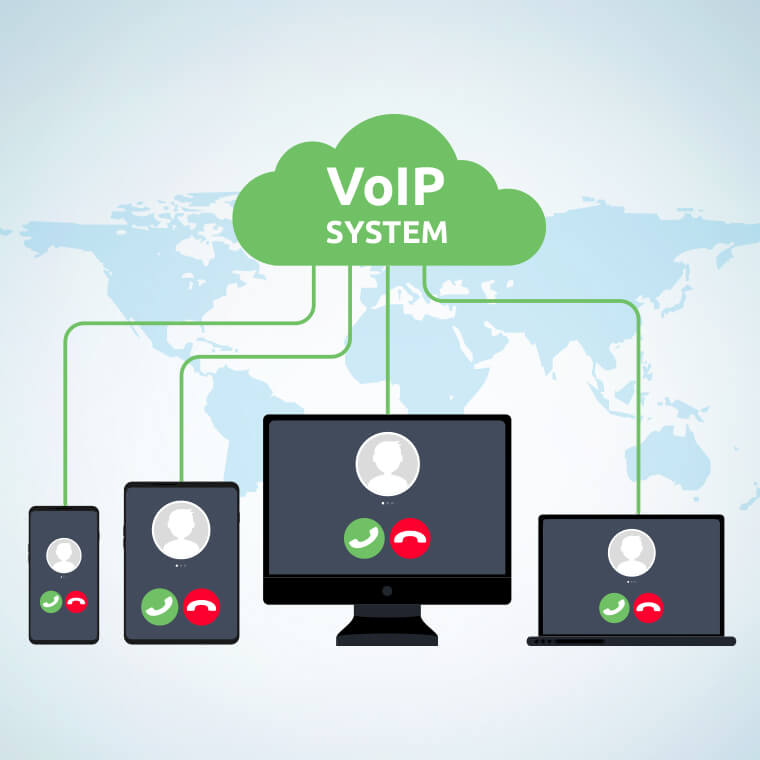
Standalone VoIP (Voice over Internet Protocol) systems have become a popular choice for dental practices seeking to modernize their communication methods. These internet-based phone systems offer cost savings and advanced call features, such as call forwarding and automated reminders. However, one key limitation is that they do not automatically integrate with dental practice management software, which can lead to siloed communications and hinder overall efficiency.
While VoIP systems can enhance communication on their own, a comprehensive cloud-based communication approach is often preferable, as it combines VoIP capabilities with seamless integration and collaboration tools to optimize practice operations.
Pros:
- Lower Costs: More affordable than traditional systems, allowing savings to be redirected toward patient care.
- Advanced Call Features: Includes call forwarding, tracking, and automated reminders to improve communication efficiency.
- Remote Work Capability: Staff can handle calls from anywhere with internet access, facilitating flexible work arrangements.
Cons:
- Stable Internet Required: VoIP depends on internet connectivity, making it vulnerable to dropped calls if the connection is weak.
- Technical Issues Possible: Users may experience call quality problems like jitter or latency, frustrating both staff and patients.
- Siloed Communications: As a standalone system, VoIP does not integrate with dental practice management software, leading to siloed communications and complicating patient record management.
4. Cloud-Based Communication Platforms
Cloud-based dental office communication systems have transformed dentistry by providing a comprehensive suite of tools that enhance connectivity and streamline operations. These state-of-the-art platforms operate via the Internet, allowing seamless integration with dental software to foster collaboration among staff and improve patient engagement. This flexibility enables dental professionals to access communication tools from anywhere, ensuring timely responses to patient inquiries and efficient appointment management.
Pros:
- Accessibility and Convenience: Staff can access communication tools from anywhere, fostering a responsive practice environment.
- Scalability: Platforms can grow with the practice, easily accommodating additional users and features.
- Cost-Effectiveness: Lower upfront costs compared to traditional systems, with subscription models that eliminate significant capital expenditures.
- Integration with Other Tools: Seamless integration with practice management software enhances workflow efficiency.
- Real-Time Collaboration: Features like shared calendars and instant messaging improve productivity and responsiveness.
- Automatic Updates: Regular updates ensure access to the latest features without manual intervention.
- Enhanced Security Measures: Incorporates strong cybersecurity features to protect patient information and comply with regulations.
- Analytics and Reporting: Provides tools to monitor communication metrics, aiding in decision-making and operational improvements.
Cons:
- Internet Dependence: Requires reliable internet; downtime could possibly disrupt communication.
- Security Concerns: Risks of data breaches necessitate careful provider selection.
- Subscription Costs: Ongoing subscription fees can accumulate, requiring budget considerations.
The Power of an Integrated Communication System
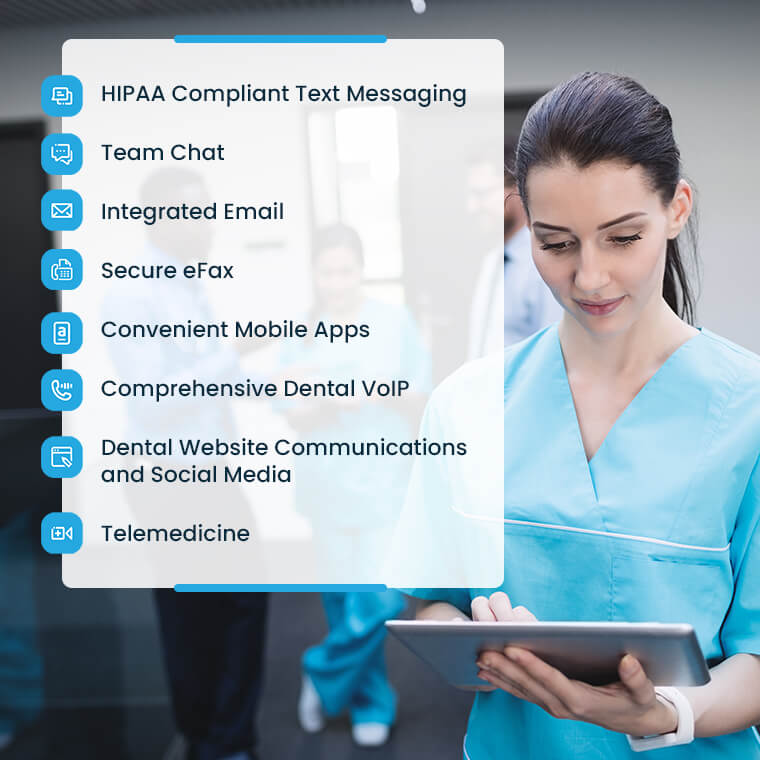
An integrated dental office communication system plays a vital role in modern practices, combining multiple channels into a cohesive network that improves patient care and clinical efficiency. Let's explore how these key cloud-based features work together to enhance your practice.
HIPAA Compliant Text Messaging
Dental patient texting is a fast and convenient way to keep patients informed and engaged. It offers an immediacy that other forms of communication may lack.
- Appointment Reminders: Send automatic text reminders to reduce no-shows and ensure patients are well-prepared for visits.
- Confirmations: Enable patients to confirm appointments with a simple text reply, minimizing phone calls and administrative work.
- Patient Outreach: Use text messaging for recalls and follow-up care, making it easy to stay connected post-treatment.
- Personalized Communication: Tailor texts to individual patients, ensuring they receive relevant, personalized information.
Patient texting is an efficient and highly personal communication method, helping to streamline patient interactions while reducing administrative workloads.
Team Chat
Dental practice chatter tools like internal chat promote real-time communication between team members, improving coordination and reducing miscommunication in busy dental environments.
- Instant Messaging: Quickly share patient updates, treatment notes, or general office needs between staff members.
- Collaboration: Use chat to discuss treatment plans and patient care without interrupting workflow.
- Mobile Access: Connect with team members even when they are away from their desks, using mobile chat capabilities.
- Task Management: Track tasks and responsibilities within chat conversations to stay on top of office duties.
In-house chat strengthens collaboration, enabling teams to communicate efficiently and stay organized during the day-to-day operations of a dental office.
Integrated Email
Dental email software offers a reliable and documented form of communication that can be used for more formal or detailed exchanges.
- Patient Notifications: Send reminders, post-visit care instructions, and updates directly to patient inboxes.
- Treatment Plans: Provide patients with detailed, written plans they can refer back to for clarity and peace of mind.
- HIPAA-Compliant Encryption: Ensure that email communications are secure, maintaining patient confidentiality.
- Customized Campaigns: Use email for marketing campaigns or targeted patient outreach, driving engagement and retention.
Email is an essential communication tool for dental practices, offering versatility and a written record for both administrative and patient-related matters.
Secure eFax
eFax allows dental offices to handle faxing electronically, simplifying the transfer of important documents like referrals and insurance claims.
- Electronic File Transfer: Send and receive documents securely and without paper, reducing office clutter.
- Integrated with Dental Software: Automatically attach important documents, such as patient histories, directly into their records.
- HIPAA Compliance: Ensures that all faxes sent and received meet regulatory standards for patient privacy.
- Audit Trail: Keep track of sent and received faxes with a detailed digital record for easy reference.
eFax streamlines administrative workflows by eliminating the need for physical paperwork and ensuring secure document transfers.
Convenient Mobile Apps
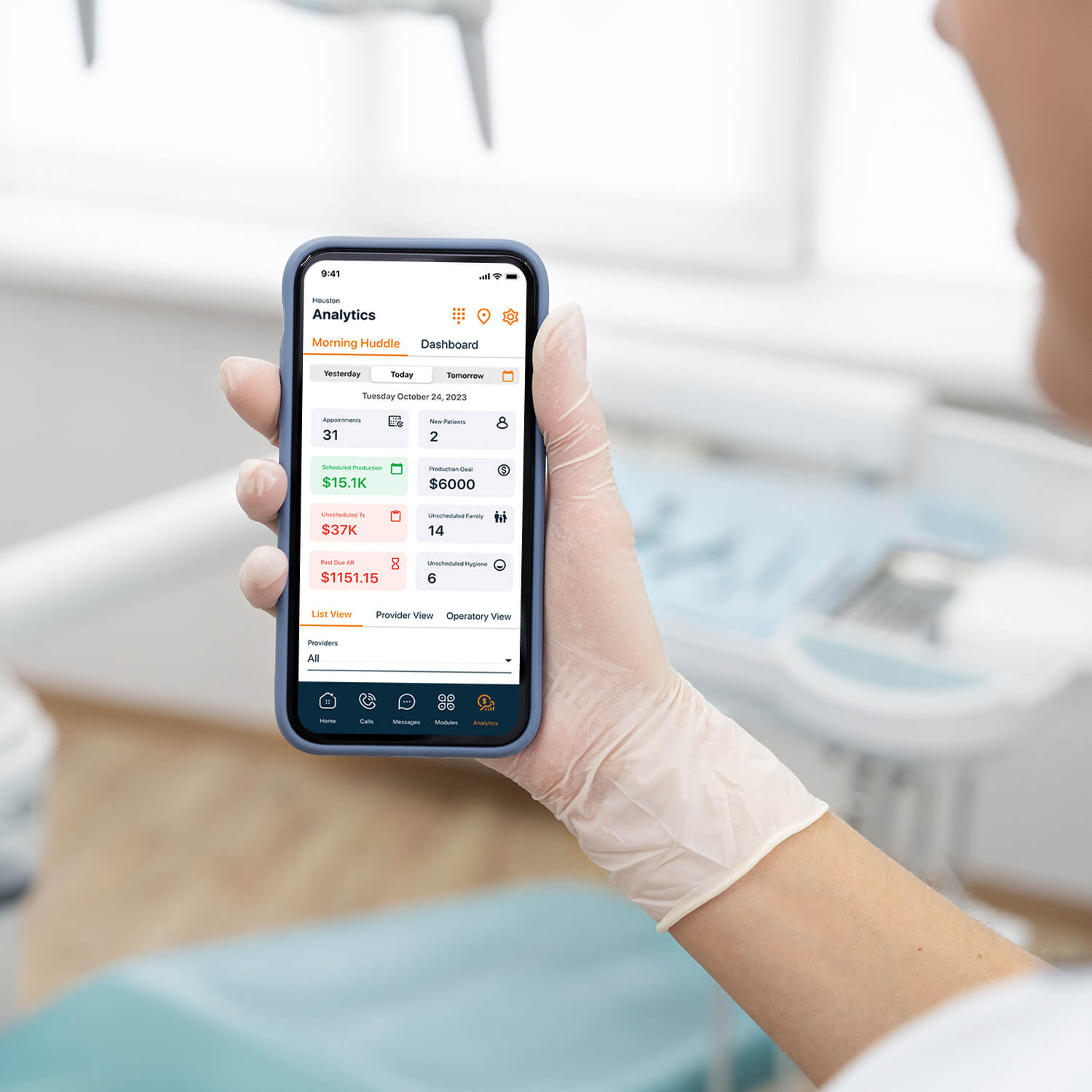
A dedicated mobile app provides dental offices with flexibility, enabling team members to stay connected and responsive from anywhere.
- Remote Communication: Allow staff to answer calls, respond to chats, and send texts from their mobile devices, even outside the office.
- Appointment Management: Staff can monitor and update appointments from their mobile phones in real-time.
- Real-Time Updates: Stay informed with instant notifications on patient communications and office needs.
- Patient Messaging: Engage with patients via texting, calls, or email while on the go, improving responsiveness and care.
Mobile apps empower dental staff with the tools they need to manage communications remotely, fostering productivity and flexibility in dental offices.
Comprehensive Dental VoIP
VoIP (Voice over Internet Protocol) dental phone systems centralize communication and data, providing a unified approach to phone calls, messaging, and more.
- Data Centralization: Integrates with your dental software to centralize patient data, eliminating information siloes and improving workflow.
- Lower Costs: VoIP eliminates the need for expensive landlines and offers affordable long-distance calling.
- Scalability: Add more lines or features as your practice grows, without significant infrastructure investment.
- Advanced Features: Call recording, analytics, and automated reminders improve both patient engagement and internal communication efficiency.
VoIP transforms communication in dental offices by integrating systems and data, allowing your office to scale efficiently while providing more advanced features and reducing costs.
Dental Website Communications and Social Media
Incorporating website communication tools and social media into your practice enhances patient engagement and expands outreach.
- Live Chat: Allow visitors to your website to initiate real-time conversations, answer questions, and schedule appointments instantly.
- Social Media Engagement: Utilize platforms like Facebook and Instagram to share updates, promote services, and connect with the community, fostering a sense of belonging among patients.
- Targeted Promotions: Use social media for targeted marketing campaigns, reaching potential patients where they already spend time online.
- Feedback and Reviews: Engage with patient reviews and feedback on social media to build trust and improve your practice's reputation.
Website communications and social media create a comprehensive strategy for reaching and interacting with patients, ensuring they have multiple ways to connect with your practice.
Telemedicine
Dental telemedicine software offers patients the convenience of remote consultations, enhancing access to care while maintaining a personal touch.
- Virtual Consultations: Provide patients with the option to consult with dental professionals via video calls, reducing the need for in-person visits for non-urgent matters.
- Follow-Up Appointments: Conduct follow-up checks after procedures or consultations, ensuring ongoing patient care and satisfaction.
- Convenient Access: Allow patients to connect from their homes, making dental care more accessible for those with mobility challenges or time constraints.
- Enhanced Patient Experience: Increase patient satisfaction by providing flexible care options that fit into their schedules, leading to better engagement and loyalty.
Telemedicine enriches your practice's offerings, making it easier for patients to receive care while helping your office run more efficiently.
Say Goodbye to Communication Chaos with Adit
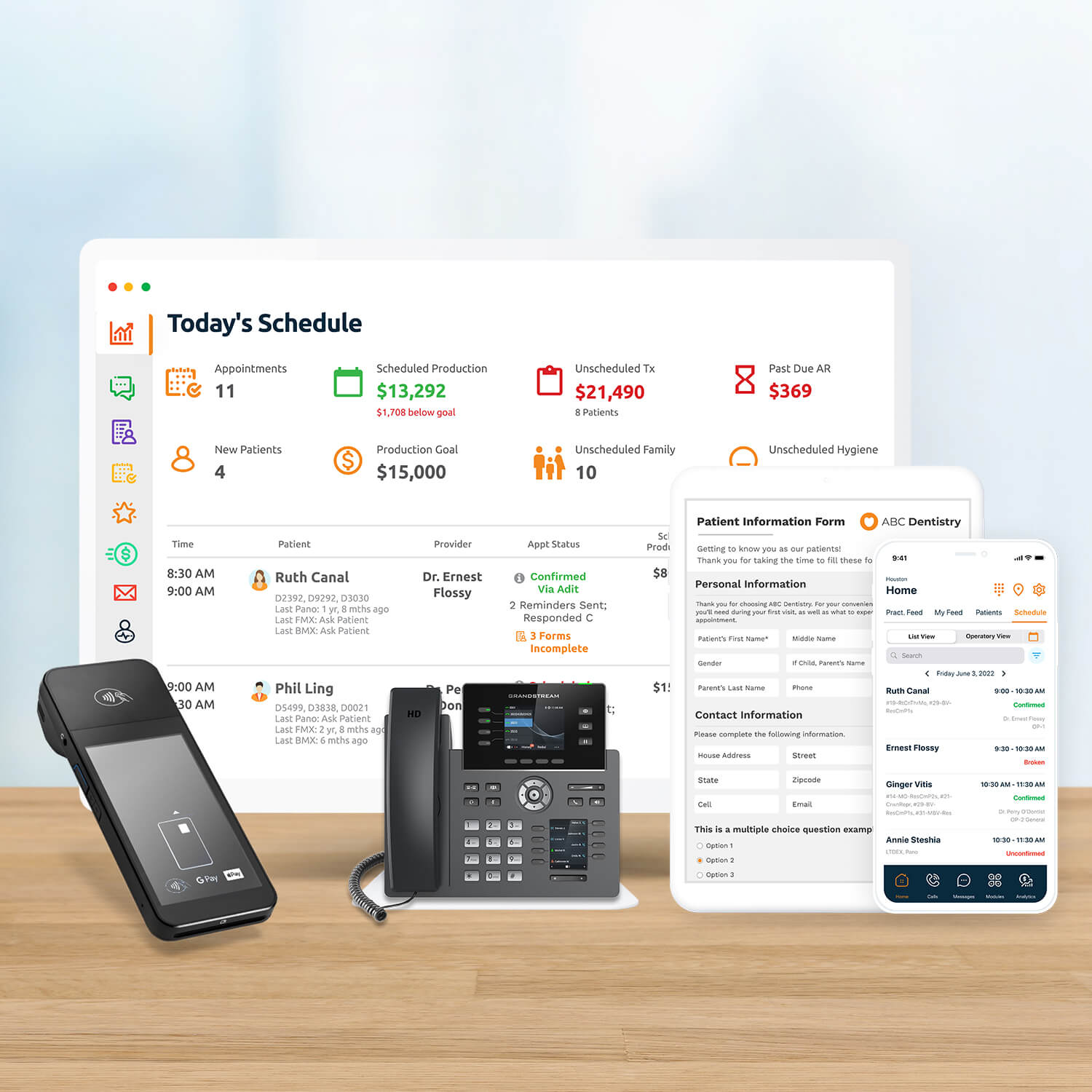
When choosing a communication system for your dental practice, Adit's dental office communication system stands out as the all-in-one solution designed specifically for the needs of dental professionals. Our integrated platform brings together essential communication features, ensuring your practice runs efficiently and effectively.
Key Benefits of Adit Dental Software:
- Comprehensive Integration: Adit practice management tools seamlessly integrate with a wide range of popular dental software, eliminating data silos and providing a unified communication experience for your team and patients.
- Advanced Communication Features: From automated reminders to secure patient messaging, our software enhances engagement, boosts patient satisfaction, and improves staff collaboration.
- Cost-Effective Solutions: Adit Dental Software offers competitive pricing compared to traditional systems while delivering a full suite of features that streamline operations and reduce overhead costs.
- Scalability to Support Growth: As your practice evolves, Adit Dental Software scales with you, allowing you to add new functionalities and tools as needed.
Transform Your Practice with Adit Dental Software
Selecting the right communication system is critical to the success of your dental office. Adit Dental Software provides your team with robust features that enhance patient engagement, streamline workflows, and foster collaboration among your team.
As part of our comprehensive platform, Adit Dental Software includes over 17 essential tools that work together to optimize your practice's communication, including:
- Adit Voice
- Online Scheduling
- Automated Reminders
- Patient Forms
- Insurance Verification
- Treatment Plans
- Adit Pay
- Call Tracking and Recording
- Practice Analytics
- Patient Text and In-house Chat
- CareCredit Integration
- Email and eFax
- Patient Recall
- Pozative Reviews
- Mobile App
- And more!
Don’t let outdated communication methods hold your practice back. Schedule a free demo with Adit today to see how your dental office communication system can enhance patient care and your overall operational excellence.

Angela Ledford
Director of MarketingAngela is a former English teacher turned marketing content specialist. Over the past 10 years, she’s developed marketing strategies to forge enduring bonds between B2B, B2C and SaaS companies and their clients through holistic education, effective communication, and captivating storytelling that moves audiences to act.






